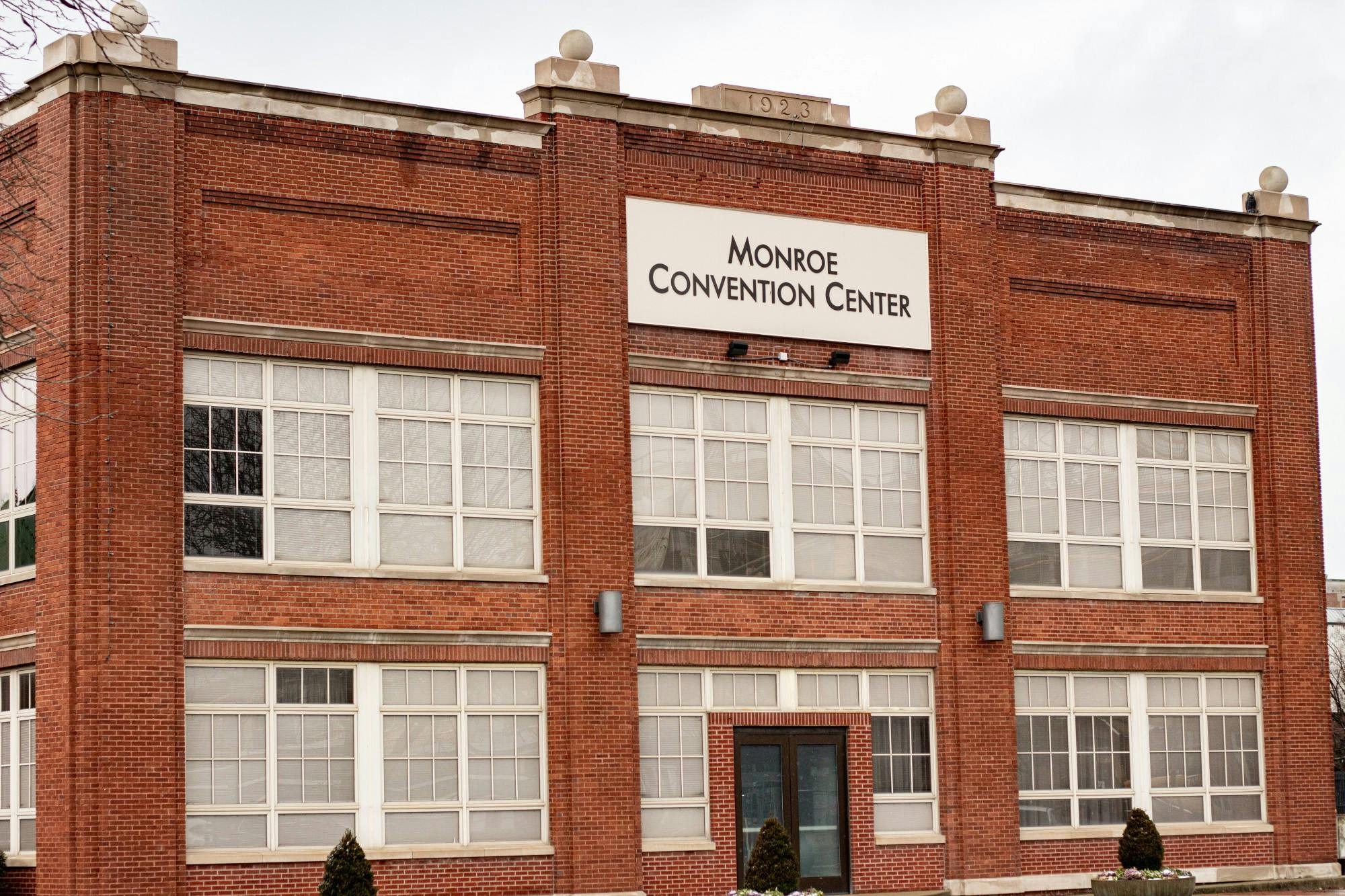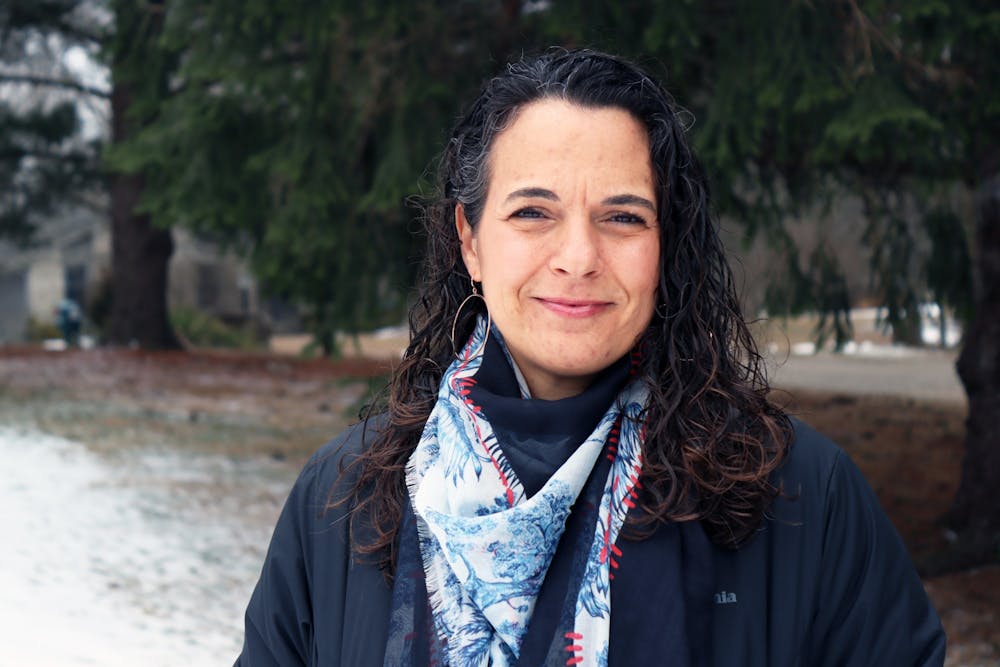She sets up her station as the sun rises, sectioned off by small partitions from the other five nurses on the Convention Center floor. Everything — gauze, hand sanitizer, wipes, laptop, Band-Aids and all her vials of vaccines for the day — must be in place.
She’s dressed in the sweater and jeans she picked out the night before — so she wouldn’t wake her husband at 5 a.m.. It’s her comfortable outfit. Now two years after her retirement, she doesn’t own any hospital scrubs. She’s wearing a mask and gloves, and she’ll only spend up to 10 minutes with each patient.
But even in that brief interaction, the 44-year-old retired nurse sees a grateful look on her patients' faces. She sees the worry from a year living in fear begin to fade.
Often, she helps her elderly patients into their chairs and takes off their jackets and warm clothing so she can reach their frail arms. She runs through the same list of questions: “Do you have any allergies? Can you confirm your date of birth? What time can we schedule your next appointment?”
Related: [IU Health Bloomington COVID-19 vaccine site and community testing site closed Tuesday]
Most patients look away with the needle in their arm, but she said none of her patients have complained of any pain. There’s no noise other than the quiet conversation of other nurses asking their patients the same questions, and those chatting in the waiting room for 15 minutes after their shot.
Lexie Matthews has met people who cried when they received their COVID-19 vaccination. Many tell her stories of the people they’ve missed, the ones they haven’t seen in nearly a year. Others, Lexie said, are reluctant, saying their children or grandchildren told them to.
She vaccinated her first grade teacher. Lexie recognized her name.
She also vaccinated a grandmother yet to meet her grandchildren. The grandmother was already eagerly awaiting her second dose the moment she got her first, desperate to meet them in person.
“Are you all volunteers here?” Lexie remembers another woman asking.
“Yes, I am, and for the most part everybody is,” Lexie said.
“Well, you are all going to heaven,” the woman responded.
But getting to the end of the pandemic means going through hell first.
The national roll out of COVID-19 vaccines has sped up dramatically in the new year, but it has continued to fall short of projections from the Trump administration when the Moderna and Pfizer vaccines were first approved.
The Trump administration promised 20 million Americans would be vaccinated by the end of December. According to Reuters, only 2.8 million total doses were given out in December. Reuters reported local health officials across the country did not receive enough federal funding to hire proper staff sizes to run vaccination clinics at the pace originally hoped for.
Related: [Monroe Co. sheriff asking Indiana health officials to vaccinate incarcerated people]
Now, in mid-February, the United States finally reached over 50 million total vaccines administered, according to the CDC website. The CDC also reports Indiana ranks 16th for total doses administered in the U.S. as of Feb. 14. In Indiana, 816,758 people have received one dose and 336,827 people are fully vaccinated as of Feb. 15, according to the state’s vaccine dashboard.
In Indiana, all individuals above the age of 65 are currently able to receive the COVID-19 vaccine.
Vaccines in Monroe County were first distributed at the IU Health Bloomington Hospital, starting in December. During the week of Jan. 11, the county opened its own additional distribution site, at the Monroe County Convention Center. The Convention Center only gives out the Moderna vaccine. The hospital has both Moderna and Pfizer doses.
The Convention Center averages roughly 190 inoculated patients each day it is open, Monroe County Health Administrator Penny Caudill said. She estimates someone is vaccinated every two minutes, on average. Nearly 16,000 people in Monroe County have received at least one dose as of Feb. 15.
Related: [More than 50% of Hoosiers over 65 have scheduled or received first dose of COVID-19 vaccine]
On an average day, Lexie will vaccinate between 30-50 people at the Monroe County Convention Center.
Since the beginning of the pandemic, Lexie knew she wanted to be part of making life closer to normal again. She’s one of a few dozen volunteers in Bloomington, pushing to vaccinate as many people each day as possible as new, more contagious strains of the coronavirus begin to arrive in the United States.
“I think the vaccine was pretty much our only plan, our only real plan of how we were going to beat this virus, or at least keep it somewhat under control,” Lexie said. “So, I see the vaccines and the vaccine effort as such a big deal.”
Lexie remembers reading emails from the state and watching news reports on the progress of COVID-19 vaccine trials last summer and fall. She remembers wanting to be involved, to help however she could.
Even though she’d been retired from her nursing career for two years, she was ready to begin treating patients again, as soon as she could.
Lexie and her family have deep roots in Bloomington. Her father, grandfather and father-in-law are all doctors in Bloomington. She went to Bloomington High School South, and her husband went to Bloomington High School North.
Lexie worked as a nurse here for more than 15 years. She worked at the IU Health Bloomington hospital in the surgery and labor units as well as at The Eye Center.
But in November 2018, with strenuous schedules between her and her husband, Lexie retired to take care of her children — her 12-year-old son Weston and 10-year-old daughter Caroline.
When the pandemic came, Lexie and her children spent all day in the house. Her kids were on their school-distributed iPads all day, and they would sometimes ask her for help with concepts she didn’t remember.
“I wasn't so great, so I had to Google a lot of stuff on my own,” Lexie said. “They would read these poems that were cute and great and everything, but I couldn't remember the terminology for all the different types of poems. It’s one of those concepts I didn’t even know how to explain to her.”
Caroline and Weston’s classes returned to in-person sessions in September, leaving time at home for Lexie as the pandemic continued on around her. She said the time was boring, but she knew the vaccine was coming.
So she waited for her chance to help the Bloomington community. That’s all she was looking forward to. She knew the vaccine distribution process would need nurses to administer the shots, and she’d known for months she wanted to be one of them.
“I definitely wanted to be involved and be involved in any way possible,” Lexie said.
Caudill said it’s been hard to get long-term information about how many doses the state is distributing to the county. She often finds out on a weekly basis how many doses Monroe County will get from the state in a given week.
“We've got people waiting in the wings to get it,” Caudill said. “We could open up additional sites. We have a lot of demand. So, if we could get lots of vaccine, we could get lots of vaccines out to people. The state just hasn't been getting a lot.”
Related: [IU Black student leaders plan to take COVID-19 vaccine, encourage cautious peers]
Caudill said it was unclear why the state and Monroe County have not been receiving anticipated supply. The state requests vaccines from the federal government, but doesn’t always get the full amount it asks for. Once Indiana receives its supply, the state government then decides how many doses are shipping to each local community.
And now, in the middle of February, the first set of people to receive their first dose from the Convention Center are starting to return for their second. That means the rise in demand for appointments is far outpacing the number of doses available, Caudill said.
Patients are immediately scheduled for their second dose when they receive their first. Because there are a fixed number of appointments available, that means fewer slots are available for people to receive their first doses.
The more doses of the COVID-19 vaccine a county uses from what it currently has, the more it will receive in future shipments, Caudill said. That’s one reason why it’s important to use all of the surplus.
Each vial has 10 doses, and if the final person of the day requires a nurse to open a new vial, the rest must be used up that day or thrown away, Caudill said.
“There’s not much,” Caudill said of surplus doses. “Some days we have none. And none is our goal.”
Lexie said there are only a small handful of doses left at the end of her shifts. Indiana is currently administering around 76% of its given vaccines as of Feb. 14, according to the CDC’s data.
There is currently a standby list with more than 4,000 names to receive surplus doses in Monroe County. If selected, the patient must be able to arrive at the facility within 30 minutes of notification.
The list is prioritized by age. The older a person is, the higher up they are on the list.
“This the first time that being old gets you something good,” Lexie remembers an elderly patient telling her.
With an extra dose in her vial, the first person she thought to call was her 77-year-old mom.
“Can you be here in 15 minutes?” Lexie asked her.
It was the end of Lexie's shift on Jan. 16, the first week the Convention Center clinic was open. There was not yet a formal wait list, and Lexie had to finish her vial.
Her mom made it just before the facility closed. She was proud she dressed correctly, as Lexie had told her — a short sleeve shirt under her long-sleeved top.
Lexie helped her mom take off her long-sleeved shirt and roll up her sleeve to reach her deltoid. Coming from a family of doctors, there she was, vaccinating her mom, taking her one step closer to living with fewer worries.
After Lexie gave her mother her first dose of the vaccine, the two sat in the designated waiting area and scheduled her next appointment. They were the only ones left in the room. The clinic had closed, and Lexie remembers her mom telling her she was happy and grateful.
Many patients tell Lexie how relieved they are to receive the vaccine, but it makes Lexie just as relieved to distribute it. Even as she sluggishly forces herself out of bed at 5 a.m. each Saturday, she feels a sense of purpose.
She said her two cups of coffee before leaving the house tend to help, too.

She could see how much it meant to her mom and all the elderly patients she’s had. For nearly a year, those elderly patients have sheltered in their homes, hiding from a pandemic where they have the most to lose. Over 486,000 Americans have died from COVID-19. Roughly 80% of those deaths are from those ages 65 or above, according to CDC data.
“I think it’s our best chance at winning the race,” Lexie said of the COVID-19 vaccine.
Lexie and her mom both received their second doses last week. Her work in the clinic along with her own completed vaccination gives Lexie hope for a return to her life before the pandemic. She wants to take her kids back to their robotics and gymnastics practices again. She wants to be back with her own family safely again.
And by giving out the vaccine, Lexie is helping families she’ll never meet regain their own sense of normalcy. She hears stories of the lives she’s bringing back together again.




